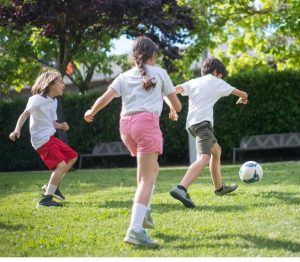
June 5, 2023, by Rupert Knight
Moving beyond rigidly sticking to ‘My-turn, Our-turn, Your-turn’
In this post, Marc North problematises the rigid way in which the ‘My-turn, Our-turn, Your-turn’ approach is applied in some classrooms.
There are a number of approaches common in schools at the moment that atomise teaching into a series of clearly defined actions. Rosenshine’s Principles of Instruction is a particularly popular example of this. These perspectives are helpful for breaking down the complex and intricately interwoven activities of a teacher into a series of clearly defined and boundaried actions, which then makes it easier to focus attention on specific actions. For example, for directing a beginning teacher’s attention to a specific aspect of a more experienced teacher’s practice (like modelling, or questioning, or scaffolding). What is arguably less helpful is when these approaches are translated and operationalised at a classroom level into a rigid framework from which deviation is discouraged … like a recipe or checklist which, if followed, will supposedly lead to positive learning experiences and improved outcomes for all children.
The ‘My-turn, Our-Turn, Your-turn’ framework common in many classrooms currently is a particular case in point here, as seen in this video. Broad and complex ideas around explicit modelling, scaffolding, collaboration and independent application of learning have been simplified and operationalised into this 3-step framework to offer a strongly framed, linear, small-steps sequence for teaching and learning. In some schools, the rigidity of this framework is treated as being of paramount importance to ensure ‘fidelity’ to the approach. On one hand, this is helpful for supporting teachers to develop a shared understanding of specific aspects of teaching and, so, for facilitating a degree of teaching consistency across different classrooms and key stages.
However, there are aspects of this approach that are problematic from a learning theory perspective and, as such, could be detrimental to children’s learning when applied rigidly. My aim below is to explore these issues in more detail by reflecting on a recent (terrifying!) experience – being a passenger while my son is learning to drive – that has challenged my thinking about how we learn.
The adventures of Josh and Papa Smurf
This is Josh (or Joshua when he’s in trouble) … and Josh is learning to drive in Papa Smurf.

After several terrifying trips as a passenger in the car this week (Josh is actually a really good driver – I’m just a scaredy-pants), a number of things struck me about his learning process.
You have to do it yourself (with support from others)
We learn to drive (or learn to play an instrument, or learn to play a sport, or learn to speak a language, etc.) by being fully involved in the activity and by taking a significant degree of responsibility over our learning. Yes, we may draw on the expertise and advice of others to support, scaffold and direct our learning, but just watching someone do something else isn’t enough. Josh has had 20-odd years of watching his parents take ‘My-turns’ in the car and it really hasn’t equipped him for doing it himself. Of course, when we have taken ‘My-turns’ we may have talked to him about driving, helped him to understand the rules of the road, and have hopefully modelled responsible driving habits. But he will only learn to drive by getting into the driver’s seat and having extensive ‘Your-turn’ opportunities – supported by a combination of ‘My-turn’ and ‘Our-turn’ experiences by an instructor and his parents – to develop and apply his learning, including getting things wrong and having to deal with the consequences of this!
You have to want to do it
Intrinsic motivation is an essential component of learning (to drive or learning to play an instrument, or learning to play a sport, or learning to speak a language, etc.). You won’t succeed in any of these activities if you aren’t personally motivated and invested. And you won’t succeed or keep trying if you don’t experience success at regular intervals or if you don’t feel like you are making progress. If you keep failing your driving test, eventually you will want to give up trying – which makes you realise what an awful and traumatic experience it must be for GCSE-resit students who keep having to resit. In addition, you won’t be personally motivated or invested if you don’t get enough ‘Your-turn’ opportunities: having to always wait for someone else to first explain something to you before you are allowed to have a go yourself both disempowers and demotivates personal responsibility for the learning.
Learning is enhanced when it is done as a collaborative activity

It’s incredibly hard to learn to drive (or learn to play an instrument, etc.) on your own. As many of you will know first-hand, learning to drive can be a completely overwhelming experience. There are just so many things going on at once, so many things to remember, so many things to do, and so many instructions and messages to process – note the similarities here with what learning in many lessons is like for many children.
But, if we treat learning as a collaborative activity and include an experienced other, this can make a significant difference to the learning process – for example, see these posts from Oracy Cambridge, NRICH Maths and the Education Endowment Foundation. This is why sports teams use coaches and people pay money for music or language lessons. We also learn by having conversations with other people and not just with experienced others. Josh talks to his friends about their experiences of driving, the things they have struggled with, and the things they are excited about, and this motivates him in his own learning and makes him feel better when things don’t go as well as he might hope for. These ‘Our-turn’ moments with the experienced other and with other learners provide an essential source of support, inspiration, motivation, and confirmation.
‘My-Turns’ are important, but not in every lesson
To deal with the overwhelm factor, a good driving instructor (just like a good teacher or coach) will employ a number of deliberate strategies that break the learning experience into manageable chunks, scaffolding the experience by focusing attention on different learning points and actions at different stages of the learning journey (see this previous blog in the series from Rupert Knight for more ideas on the importance of modelling).

During this learning journey, there may be times where a ‘My-turn’ demonstration (direct instruction or modelling) is needed – like how to parallel park or do a hill stop, or how to hold an instrument or tennis racket, or where to position your fingers. This explicit modelling is an important dimension, particularly when there are novices involved in the learning process. But, this modelling is usually only necessary when there is something new or technical to learn and master, and certainly does not need to happen during every learning session. In fact, it can be counterproductive for the instructor or teacher or coach to do too many ‘My-turns’ in a lesson because this leaves less time for the learner to practise and develop their own skills.
‘My-Turns’ are important, but don’t always need to be done first
Always doing a ‘My-turn’ first creates a particular power-dynamic in the learning process and sends a strong message to the learners that teachers hold all of the knowledge and that they don’t believe that the learners have anything to contribute to the learning process until they have first transmitted that knowledge to them. Knowing Josh, he really would not have been motivated to continue driving lessons with his instructor if the first 20 minutes of every driving lesson involved his instructor independently demonstrating and explaining new actions. I’ve also noticed that sometimes in classrooms where the ‘My-turn’ always comes first, opportunities for collective whole-class discussion, exploration and investigation are closed down because the children have to wait on the teacher to tell them how to do things.
Sometimes, you learn more and the learning is more meaningful and memorable (which supports memorisation and consequent retrieval) when you get to explore on your own (‘Your-turn’) or with other learners (‘Our-turn’), to figure things out for yourself or collectively, rather than having to wait on and replicate someone else’s demonstration or explanation. In these situations, the role of the instructor (or teacher or coach) shifts to noticing the learning that is or isn’t taking place and then offering targeted support – in other words, ‘Assessment for Learning’. This targeted support could include a short demonstration if that would be helpful. Sometimes this demonstration might come in the middle of a learning experience if the instructor notices that the learner is struggling with something specific, or sometimes at the end to reinforce some messaging (not yet fully grasped) from the current lesson or to lay the foundation for the next lesson. Whatever the case, the need for a ‘My-turn’ and when this occurs should be motivated by what will work best to support the learner’s progress.
Practise, practise, practise, practise … and then practise some more!

Josh’s driving will improve because he gets in the car on a regular basis and drives, drives, and drives some more, and then some more again. The more he practises (‘Our turn’ and ‘Your turn’), the easier and more automated some things will become (I long for the day when he will stop looking at his feet whenever he changes gears!). And the more automated some things become, the easier it will be for him to learn and deal with more sophisticated driving challenges and learning. What’s happening here is that by repeatedly practising the same things over and over again until they are automated, these become fully encoded into his long-term memory such that his working memory is freed up to focus on other actions and new learning. And then one day the entire act of driving will become so automated that he will have that surreal experience of arriving home and wondering how on earth he had managed to do that because he hadn’t concentrated at all on his driving for the entire trip. Jane Morris argues a similar point in her previous blog in the series on ‘Practice Makes Perfect’ using the lens of ‘Skills Acquisition Theory’, and that is well worth a read if you want to think about some of these ideas from a more theoretical perspective.
It’s also worth point out that because Josh is still learning, every time he gets into the car he always starts off practising the same basics again and again – check mirrors, check blind spot, accelerate, gear up, gear down, brake, and so on. Each lesson builds on learning and experiences from the previous lesson, with clear connections and continuity between each learning experience (both Carmen Mohammed and Cath Gripton also talks about the importance of connections in their previous blogs on ‘The importance of memory in learning’ and ‘Remember remember’). It’s worth considering whether students have the same experience in your lessons, or whether they see each lesson as a separate learning experience focused on new learning. Each driving lesson also involves a higher proportion of repetition and practice over new learning, with the new learning commonly coming once he has re-established and demonstrated confidence with the basics – there is no point moving on to a new technique if he is still struggling to grasp what he was working on during his last lesson.
There are some overlaps here with the importance of retrieval practice in lessons, particularly repeated practice of things learned recently and/or which directly link to the current learning focus. There are also some overlaps here with the importance of the independent practice stage of a lesson: the more students get to apply and practise the new learning, the better the chance this learning will be encoded into longer term memory. With this in mind, it may be worth considering what proportion of each lesson is dedicated to ‘Your-turn’ and ‘Our-turn’ activities in comparison to the ‘My-turn’ input, since it’s usually the essential ‘Your-turn’ practice- and application-of-new-learning activities that get cut short if the lesson overruns.
Flexibility is key
The ’My-turn, Our-turn, Your-turn’ structure contains all of the elements needed to support positive learning experiences: some explicit modelling by an experienced other, opportunities for working collaboratively to share learning, and opportunities to check understanding by practicing and applying learning independently. So, it’s not the structure itself that is problematic; rather, it’s unhelpful and possibly even detrimental when the rigidity of the structure is prioritised over what might work best to support and inspire the children’s learning. And, this applies also to all other approaches too: when we translate and operationalise the complex and intricate activities of teaching and learning into a prescriptive sequence of actions, when run the risk of offering oversimplified learning experiences that are disempowering and unengaging because they don’t accommodate the dynamic way in which learning occurs.
For example:
Let’s say in Maths you want the children to learn to compare the sizes of different fractions (e.g. Which is bigger? 2/3 or 3/4), ultimately leading to an understanding of converting different fractions to have the same common denominators.

An alternative to showing the children how to do this would be to acknowledge that the children already have some pre-knowledge of fractions and start with the children working collaboratively (‘Our-turn) to explore as many ways as possible to prove which one is bigger. You could then select a number of the children’s methods to showcase on the board, discussing the connections between the methods but also the advantages and limitations of each method. You could then justify your reasons for focusing on a specific method for this lesson and then demonstrate that method (‘My-turn’) to ensure that all children understand the method. The children could then be given the opportunity to work collaboratively again (‘Our-turn’) or individually (‘Your-turn’) to demonstrate their understanding of the method. The learning structure here would be: ‘Our-turn’ → ‘My-turn’ → ‘Our-turn’ / ‘Your-turn’.
As another example, let’s say in Art you want the children to use a particular technique when creating a clay model.

Recognising that the children will bring different artistic skills with them into the classroom environment, rather than strongly controlling the learning experience by first modelling explicitly for the children how to use the technique, you could have a pre-prepared model on display. The children could be given a go to work individually initially to try to recreate the model (‘Your-turn’). This individual work could be interspersed with regular ‘Our-turn’ collaborative experiences and discussions where the children share with each other and the whole class what techniques they are using and why, and the pros and cons of these. If necessary, you could interject with a demonstration for the whole class or you could choose to work with a small group that you have observed need additional support (‘My-turn). You could then end the lesson with a brief ‘My-turn’ input to draw out the key learning for the lesson. The learning structure here would be: ‘Your-turn’ → ‘Our-turn’ → ‘Your-turn’ → ‘Our-turn’ → ‘Your-turn’ (for some) & ‘My-turn’ (for all or for some) → ‘My-turn’ (for all).
Some questions that you may want to reflect on to guide your classroom practice
- To what extent do you value the children’s pre-knowledge on a topic and what knowledge and understanding do you assume the children already bring to each lesson?
- How many opportunities are there in your lessons for the children to investigate and explore ideas before being taught about those ideas, and also to do this collaboratively?
- What proportion of the lesson time is dedicated to your input versus the children working collaboratively or independently?
- How much responsibility do you give to the children for their own learning process and how much do you try to control their learning experiences?
- How do you help the children understand the connections between each lesson and how do you revisit prior learning to help them to build connections between their new and existing learning?
- To what extent do you flexibly adapt your teaching structure and approach to accommodate the children’s learning needs?
Josh is due to take his driving test in the middle of May – which I’m only mentioning in case you want to make a rapid exit if you see Papa Smurf looming behind you. When he does pass (note the positive thinking), a key contributing factor will have been the varied, dynamic, and flexible learning experience that he has been afforded by his driving instructor. A rigid one-size-fits-all approach simply would not have worked as effectively for him, and the same can be said for any of us engaged in a personal learning experience of any sort. Most of us value variety in the learning process, we value being given ownership and responsibility over our learning, we value being able to work creatively with others, and we value being able to put our learning to use in a meaningful way. The same can only but be true for the children we teach … and they deserve the same level of flexibility in their learning.
Disclaimer
No driving instructors or other drivers were harmed while I was being fearfully inspired to write this blog.
No comments yet, fill out a comment to be the first

Leave a Reply